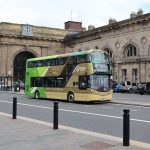[Ross – please use the pic called ‘Randerson.jpg’ to create a picture for the byline]
[top header]
opinion
[side header]
OPINION: JOHN RANDERSON
[head]
‘The day of the small bus is finally here…’
[standfirst]
Small buses have gained traction recently, and there is still a lot more to come. Mellor Managing Director John Randerson takes a look at where the sector is going to
[by John Randerson – MD, Mellor]
[captions]
[1] Mellor’s Strata Ultra can carry 30 passengers, 27 seated, on a Mercedes-Benz Sprinter chassis
[2] 90 Mellor Tucana IIs are being delivered to Transport for London to satisfy ULEZ restrictions
[3] Strata range comes with the kind of fit and finish that bus users have come to expect of vehicles
[4] The Strata Plus is slightly smaller than the Strata Ultra and it can carry a total of 27 passengers
[pulls as required]
[1] Advances from manufacturers like Mellor have created significant change in the small bus sector
[2] Innovation and expertise are key to the delivery of the next generation of small buses
[753]
There was a time when a small bus would have seldom been considered a viable option for operators providing services in towns and cities. Their use was channelled through local authorities, rural routes and the welfare sector.
In recent years, that has changed significantly. With the drive to make bus services pay, as well as providing low emissions to improve air quality, the small bus is increasingly becoming a vehicle of choice with operators and it is set to come to the forefront again over the next few years.
[crosshead] Back to the future
In the mid-1980s, following deregulation, small buses were very much part of the UK scene. Indeed, they were carving a strong niche as a smaller, more cost-effective solution for operators as part of their portfolio.
That was mainly for use on rural and smaller urban routes that, while vital, had seen a steep decline in patronage, which has continued to the present day.
It was during the 1990s, with the introduction of the Disability Discrimination Act (DDA), which quite rightly set out to improve accessibility and provision for all, that major changes were brought about.
At the time, vehicle design and specification were unable to respond quickly enough to meet the new requirements, and the small bus quickly disappeared from regular use. Operators found themselves having to deploy standard-size buses on such routes. Over the years since, they have become increasingly expensive and unsustainable to run.
That in turn led to many such routes being discontinued, cutting off a vital lifeline for many in these more remote rural areas.
[crosshead] Technology is king
Recent technological advances from innovative manufacturers like Mellor have created a significant change in the small bus sector. We are now witnessing a resurgence in the market, with new models and ranges offering low or zero emissions and low running costs.
At the same time, they include the same features and benefits as their larger cousins that are expected by today’s bus traveller, be they rural or urban.
Legislation inevitable drives the development of new technologies. In the case of DDA, vehicles such as Mellor’s Orion and Tucana models were conceived and launched in the 2000s.
Those ranges have gone on to evolve to meet the needs of today’s operator and they are now manufactured and supplied in large numbers. That is notably the case for the Tucana II, 90 of which are currently being delivered to Transport for London (TfL) for its dial-a-ride services.
The Tucana IIs are seen as an important part of TfL’s efforts to clean up the capital’s toxic air, and the vehicle meets the tough new Ultra Low Emission Zone standards, which are applicable from 9 April.
They will go a long way to helping older and vulnerable Londoners to get from A to B, while protecting the health of future generations. That is a clear demonstration of the contribution that can be made by small buses in a modern, metropolitan environment.
[crosshead] Clean and green
New technologies that provide cleaner diesel and electric drivelines have been harnessed by lightweight and innovative body designs. That has helped to deliver small buses that are robust and have significantly lower capital costs, coupled with a reduced cost of ownership.
That is key in ensuring the needs of operators and passengers have been met, and that vital services that were in danger of being lost continue to be provided.
Innovation and expertise are also key to the delivery of the next generation of small buses. With the right collaboration and technical initiatives, what may have been considered impossible just a few years ago can now become a reality.
For example, having a capacity of 27 or 30 passengers on a Mercedes-Benz Sprinter chassis would have been impossible not long ago. But now, with the arrival of the Mellor Strata Plus and Strata Ultra, that has been achieved through a skilled engineering team leveraging their technical know-how and experience in the small bus sector.
[crosshead] More on the agenda
As well as halving fuel consumption and significantly reducing emissions, smaller buses inevitably have a positive impact on congestion in towns and cities.
This way of working is likely to set the standard for small bus development for the next few years. New initiatives and technologies are going to dictate the agenda for some time to come.
Future legislation will undoubtedly continue to drive the need for improvements in design, while innovation and technical expertise will also be key to continuous vehicle improvement.
Mellor will always strive towards making bus operation much more affordable, helping to protect a vital part of our transport infrastructure.
[for more information]


























